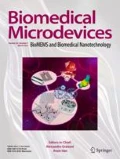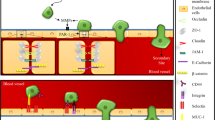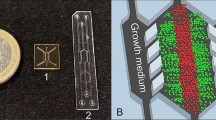Abstract
Glioblastoma (GBM) is one of the most malignant primary brain tumors. This neoplasm is the hardest to treat and has a bad prognosis. Because of the characteristics of genetic heterogeneity and frequent recurrence, a successful cure for the disease is unlikely. Increasing evidence has revealed that the GBM stem cell-like cells (GSCs) and microenvironment are key elements in GBM recurrence and treatment failure. To better understand the mechanisms underlying this disease and to develop more effective therapeutic strategies for treatment, suitable approaches, techniques, and model systems closely mimicking real GBM conditions are required. Microfluidic devices, a model system mimicking the in vivo brain microenvironment, provide a very useful tool to analyze GBM cell behavior, their correlation with tumor malignancy, and the efficacy of multiple drug treatment. This paper reviews the applications of microfluidic devices in GBM research and summarizes progress and perspectives in this field.





Similar content being viewed by others
References
E. Akbari, G.B. Spychalski, J.W. Song, Microfluidic approaches to the study of angiogenesis and the microcirculation. Microcirculation 24(5), (2017)
E. Alegre et al., Circulating melanoma exosomes as diagnostic and prognosis biomarkers. Clin. Chim. Acta 454, 28–32 (2016)
A. S. Arbab, et al., Major Challenges and Potential Microenvironment-Targeted Therapies in Glioblastoma. Int. J. Mol. Sci. 18(12), (2017)
L. Armbrecht, P.S. Dittrich, Recent advances in the analysis of single cells. Anal. Chem. 89(1), 2–21 (2017)
N.G. Avci et al., Investigating the influence of HUVECs in the formation of Glioblastoma spheroids in high-throughput three-dimensional microwells. IEEE Trans Nanobioscience 14(7), 790–796 (2015)
J.M. Ayuso et al., Glioblastoma on a microfluidic chip: Generating pseudopalisades and enhancing aggressiveness through blood vessel obstruction events. Neuro-Oncology 19(4), 503–513 (2017)
P.L. Bedard et al., Tumour heterogeneity in the clinic. Nature 501(7467), 355–364 (2013)
L. Blaha et al., A microfluidic platform for modeling metastatic cancer cell matrix invasion. Biofabrication 9(4), 045001 (2017)
E.L. Brackett, C.A. Swofford, N.S. Forbes, Microfluidic device to quantify the behavior of therapeutic Bacteria in three-dimensional tumor tissue. Methods Mol. Biol. 1409, 35–48 (2016)
D.J. Brat, B. Kaur, E.G. Van Meir, Genetic modulation of hypoxia induced gene expression and angiogenesis: Relevance to brain tumors. Front. Biosci. 8, d100–d116 (2003)
L. Bui et al., Role of key genetic mutations on increasing migration of brain cancer cells through confinement. Biomed. Microdevices 19(3), 56 (2017)
R.A. Burrell et al., The causes and consequences of genetic heterogeneity in cancer evolution. Nature 501(7467), 338–345 (2013)
D. Caballero et al., Organ-on-chip models of cancer metastasis for future personalized medicine: From chip to the patient. Biomaterials 149, 98–115 (2017)
X. Cai, M.E. Sughrue, Glioblastoma: New therapeutic strategies to address cellular and genomic complexity. Oncotarget 9(10), 9540–9554 (2018)
L. Cassereau et al., A 3D tension bioreactor platform to study the interplay between ECM stiffness and tumor phenotype. J. Biotechnol. 193, 66–69 (2015)
C. Chen et al., 3D-printed microfluidic devices: Fabrication, advantages and limitations-a mini review. Anal. Methods 8(31), 6005–6012 (2016)
S. Chen et al., Microfluidic assay of circulating endothelial cells in coronary artery disease patients with angina pectoris. PLoS One 12(7), e0181249 (2017)
S. De Vleeschouwer, G. Bergers, in Glioblastoma, ed. by S. De Vleeschouwer. Glioblastoma: To Target the Tumor Cell or the Microenvironment? (Brisbane (AU), 2017)
D.C. Duffy et al., Rapid prototyping of microfluidic Systems in Poly(dimethylsiloxane). Anal. Chem. 70(23), 4974–4984 (1998)
Y. Fan et al., Engineering a brain Cancer Chip for high-throughput drug screening. Sci. Rep. 6, 25062 (2016)
S. Fang et al., Clinical application of a microfluidic chip for immunocapture and quantification of circulating exosomes to assist breast cancer diagnosis and molecular classification. PLoS One 12(4), e0175050 (2017)
B.L. Fernandez-Carballo et al., Continuous-flow, microfluidic, qRT-PCR system for RNA virus detection. Anal. Bioanal. Chem. 410(1), 33–43 (2018)
B. Gale et al., A review of current methods in microfluidic device fabrication and future commercialization prospects. Inventions 3, 60 (2018)
B. Gao et al., Engineering of microscale three-dimensional pancreatic islet models in vitro and their biomedical applications. Crit. Rev. Biotechnol. 36(4), 619–629 (2016)
P. Gheibi et al., Microchamber cultures of bladder Cancer: A platform for characterizing drug responsiveness and resistance in PDX and primary Cancer cells. Sci. Rep. 7(1), 12277 (2017)
S.W. Han, W.G. Koh, Hydrogel-framed Nanofiber matrix integrated with a microfluidic device for fluorescence detection of matrix Metalloproteinases-9. Anal. Chem. 88(12), 6247–6253 (2016)
J. Han et al., Rapid emergence and mechanisms of resistance by U87 glioblastoma cells to doxorubicin in an in vitro tumor microfluidic ecology. Proc. Natl. Acad. Sci. U. S. A. 113(50), 14283–14288 (2016)
A.B. Holton et al., Microfluidic biopsy trapping device for the real-time monitoring of tumor microenvironment. PLoS One 12(1), e0169797 (2017)
S. Hong, Q. Pan, L.P. Lee, Single-cell level co-culture platform for intercellular communication. Integr Biol (Camb) 4(4), 374–380 (2012)
J.V. Joseph et al., Hypoxia enhances migration and invasion in glioblastoma by promoting a mesenchymal shift mediated by the HIF1alpha-ZEB1 axis. Cancer Lett. 359(1), 107–116 (2015)
S.J. King et al., Lamellipodia are crucial for haptotactic sensing and response. J. Cell Sci. 129(12), 2329–2342 (2016)
Y. Li et al., Cell migration microfluidics for electrotaxis-based heterogeneity study of lung cancer cells. Biosens. Bioelectron. 89(Pt 2), 837–845 (2017)
J. Lin et al., Exosomes: Novel biomarkers for clinical diagnosis. Sci. World J. 2015, 657086 (2015)
Y. Ma et al., Increased protein sorption in poly(acrylic acid)-containing films through incorporation of comb-like polymers and film adsorption at low pH and high ionic strength. Langmuir 29(9), 2946–2954 (2013)
M. Masrie, B.Y. Majlis, J. Yunas, Fabrication of multilayer-PDMS based microfluidic device for bio-particles concentration detection. Biomed Mater Eng 24(6), 1951–1958 (2014)
J.C. McDonald, G.M. Whitesides, Poly(dimethylsiloxane) as a material for fabricating microfluidic devices. Acc. Chem. Res. 35(7), 491–499 (2002)
G. Mottet et al., A three dimensional thermoplastic microfluidic chip for robust cell capture and high resolution imaging. Biomicrofluidics 8(2), 024109 (2014)
X. Mu et al., Microfluidics for manipulating cells. Small 9(1), 9–21 (2013)
P.N. Nge, C.I. Rogers, A.T. Woolley, Advances in microfluidic materials, functions, integration, and applications. Chem. Rev. 113(4), 2550–2583 (2013)
N.T. Nguyen et al., Design, fabrication and characterization of drug delivery systems based on lab-on-a-chip technology. Adv. Drug Deliv. Rev. 65(11–12), 1403–1419 (2013)
P. Occhetta et al., Design of a microfluidic strategy for trapping and screening single cells. Med. Eng. Phys. 38(1), 33–40 (2016)
T. Pham et al., Fluorescence analysis of single mitochondria with nanofluidic channels. Methods Mol. Biol. 1264, 35–46 (2015)
T.J. Plegue et al., Stability of polyethylene glycol and Zwitterionic surface modifications in PDMS microfluidic flow chambers. Langmuir 34(1), 492–502 (2018)
S.T. Sanjay et al., Recent advances of controlled drug delivery using microfluidic platforms. Adv. Drug Deliv. Rev. 128, 3–28 (2018)
T. Schneider, J. Kreutz, D.T. Chiu, The potential impact of droplet microfluidics in biology. Anal. Chem. 85(7), 3476–3482 (2013)
H. Shao et al., Chip-based analysis of exosomal mRNA mediating drug resistance in glioblastoma. Nat. Commun. 6, 6999 (2015a)
H. Shao, J. Chung, D. Issadore, Diagnostic technologies for circulating tumour cells and exosomes. Biosci. Rep. 36(1), e00292 (2015b)
C.W.t. Shields, C.D. Reyes, G.P. Lopez, Microfluidic cell sorting: a review of the advances in the separation of cells from debulking to rare cell isolation. Lab Chip 15(5), 1230–1249 (2015)
D.J. Sikorski et al., Clonal analysis of individual human embryonic stem cell differentiation patterns in microfluidic cultures. Biotechnol. J. 10(10), 1546–1554 (2015)
I.V. Smolina, N.E. Broude, Ultrasensitive detection of DNA and protein markers in cancer cells. Cancer Biol Med 12(3), 143–149 (2015)
M. Sonker, V. Sahore, A.T. Woolley, Recent advances in microfluidic sample preparation and separation techniques for molecular biomarker analysis: A critical review. Anal. Chim. Acta 986, 1–11 (2017)
A. Sottoriva et al., Intratumor heterogeneity in human glioblastoma reflects cancer evolutionary dynamics. Proc. Natl. Acad. Sci. U. S. A. 110(10), 4009–4014 (2013)
P. Spuul et al., Microfluidic devices for the study of actin cytoskeleton in constricted environments: Evidence for podosome formation in endothelial cells exposed to a confined slit. Methods 94, 65–74 (2016)
R. Stupp et al., Effects of radiotherapy with concomitant and adjuvant temozolomide versus radiotherapy alone on survival in glioblastoma in a randomised phase III study: 5-year analysis of the EORTC-NCIC trial. Lancet Oncol 10(5), 459–466 (2009)
T.B. Terrell-Hall et al., Trastuzumab distribution in an in-vivo and in-vitro model of brain metastases of breast cancer. Oncotarget 8(48), 83734–83744 (2017)
T.B. Tran et al., Electrical dual-sensing method for real-time quantitative monitoring of cell-secreted MMP-9 and cellular morphology during migration process. Biosens. Bioelectron. 77, 631–637 (2016)
M. Wang et al., Variation over time and interdependence between disease progression and death among patients with glioblastoma on RTOG 0525. Neuro-Oncology 17(7), 999–1006 (2015)
J. Wang et al., Clonal evolution of glioblastoma under therapy. Nat. Genet. 48(7), 768–776 (2016)
X. Wu et al., A versatile microfluidic platform for the study of cellular interactions between endothelial cells and neutrophils. Biochim Biophys Acta Gen Subj 1861(5 Pt A), 1122–1130 (2017)
H.D. Xi et al., Active droplet sorting in microfluidics: A review. Lab Chip 17(5), 751–771 (2017)
Z. Xu et al., Design and construction of a multi-organ microfluidic Chip mimicking the in vivo microenvironment of lung Cancer metastasis. ACS Appl. Mater. Interfaces 8(39), 25840–25847 (2016)
H. Xu et al., Probing the response of lung tumor cells to inflammatory microvascular endothelial cells on fluidic microdevice. Electrophoresis 38(2), 311–319 (2017)
K.M. Yamada, E. Cukierman, Modeling tissue morphogenesis and cancer in 3D. Cell 130(4), 601–610 (2007)
M. Yang, R. Nelson, A. Ros, Toward analysis of proteins in single cells: A quantitative approach employing isobaric tags with MALDI mass spectrometry realized with a microfluidic platform. Anal. Chem. 88(13), 6672–6679 (2016)
Author information
Authors and Affiliations
Corresponding author
Ethics declarations
Conflict of interests
Dr. Michael Sughrue is the Chief Medical Officer of Omniscient Neurotechnologies. No products directly related to this were discussed in this paper. No other authors report any conflicts of interest.
Additional information
Publisher’s note
Springer Nature remains neutral with regard to jurisdictional claims in published maps and institutional affiliations.
Rights and permissions
About this article
Cite this article
Cai, X., Briggs, R.G., Homburg, H.B. et al. Application of microfluidic devices for glioblastoma study: current status and future directions. Biomed Microdevices 22, 60 (2020). https://doi.org/10.1007/s10544-020-00516-1
Published:
DOI: https://doi.org/10.1007/s10544-020-00516-1




